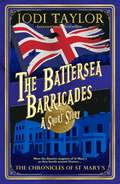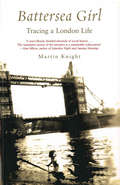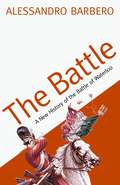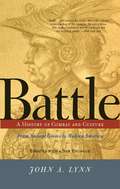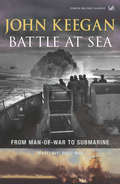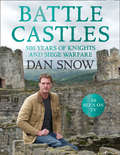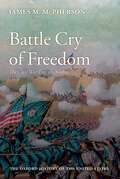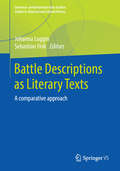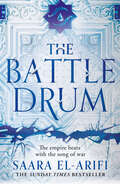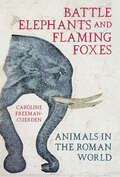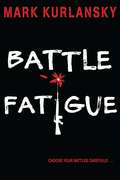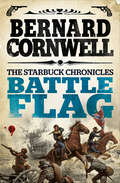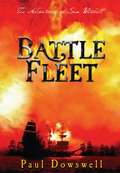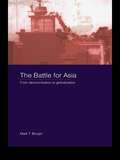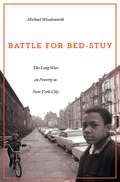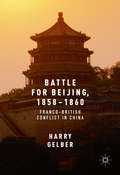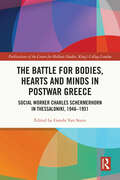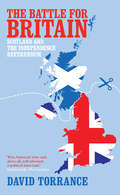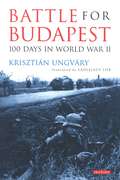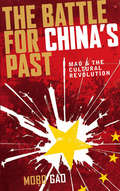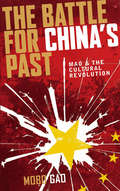- Table View
- List View
The Battersea Barricades: A Chronicles Of St Mary's Short Story
by Jodi TaylorA Chronicles of St Mary's short story that is sure to entertain. If you love Jasper Fforde or Ben Aaronovitch, you won't be able to resist Jodi Taylor. It's not easy being a rebel.So many new skills to assimilate.Never mind strategic planning, weapons expertise and the like - there's bicycle-stealing, oil-stain removal and boat steering to be mastered first.And quickly.It's the time of the Civil Uprisings and two young women set out to make a difference.Their only problem?They don't know where they are.Or where they're going.Or what to do when they get there.Other than that ...Fans of St Mary's will enjoy this glimpse into the past of some of their favourite characters. Readers love Jodi Taylor: 'Once in a while, I discover an author who changes everything... Jodi Taylor and her protagonista Madeleine "Max" Maxwell have seduced me' 'A great mix of British proper-ness and humour with a large dollop of historical fun' 'Addictive. I wish St Mary's was real and I was a part of it' 'Jodi Taylor has an imagination that gets me completely hooked' 'A tour de force'
Battersea Girl: Tracing a London Life (Soundings Ser.)
by Martin KnightA couple of years ago, Martin Knight began a quest to delve into his family history. He had a head start on many amateur genealogists, as 30 years earlier he had produced a school project on the very subject. The project was based on the papers and oral history of his then elderly grandmother, Ellen Tregent. Martin dusted this off and began to assemble the chain of events that shaped his grandmother's life. He even made contact with several living relatives who had known Ellen or some of the people and events she described.Ellen Tregent was born in 1888 and died in 1988 - her lifetime encompassing an unprecedented century of social change and world upheaval. She was born into a poor working-class family in Battersea, London. Her grandfather had arrived from Ireland 40 years earlier to escape almost certain death as potato famine ravaged his country. In Battersea Girl, Martin Knight charts Ellen's long and eventful life and the lives of her siblings. They encounter abject poverty, disease, suicide, murder, war and inevitably death, but, equally, the spirit of stoical people who were determined to make the most of their lives shines through in this enchanting book.
The Battle: A New History Of The Battle Of Waterloo
by Alessandro BarberoA vivid and original reconstruction of the Battle of Waterloo.On the afternoon of 1 March, 1815, a fleet of ships dropped anchor off the southeast coast of France. After ten months in exile on the island of Elba, the Emperor Napoleon had returned to reclaim his throne. European chancelleries responded by immediately preparing for war. Only one year earlier, four great powers - England, Austria, Russia and Prussia - had combined to defeat Napoleon and now, these four countries made a pledge to invade France from all sides. Napoleon's only recourse was to rearm, and he quickly marshalled his forces: mobilized the National Guard, began mass production of muskets and bought or confiscated all available horses. On the Allied side, by the end of spring, only the Duke of Wellington's troops and the Prussian army, under the command of Field Marshal Blucher, were prepared. The Emperor knew that by attacking the two armies separately, his Armee du Nord stood a good chance of winning. He planned a surprise strike, to destroy the first army he encountered before the other could intervene. Maintaining complete secrecy over his tactics, he manoeuvred the Armee du Nord close to the Belgian border and at dawn on 15 June, sent the first cavalry patrols over into enemy territory, followed immediately by columns of infantry. Thus begins The Battle, a thrilling new account of the great Battle of Waterloo, which survivors from all sides deemed, in the words of an English officer 'a terrible fight for a terrible stake: freedom or slavery to Europe.'
Battle: A History Of Combat And Culture
by John A LynnBattle: A History of Combat and Culture spans the globe and the centuries to explore the way ideas shape the conduct of warfare. Drawing its examples from Europe, the Middle East, South Asia, East Asia, and America, John A. Lynn challenges the belief that technology has been the dominant influence on combat from ancient times to the present day. In battle, ideas can be more far more important than bullets or bombs. Carl von Clausewitz proclaimed that war is politics, but even more basically, war is culture. The hard reality of armed conflict is formed by - and, in turn, forms - a culture's values, assumptions, and expectations about fighting. The author examines the relationship between the real and the ideal, arguing that feedback between the two follows certain discernable paths. Battle rejects the currently fashionable notion of a "Western way of warfare" and replaces it with more nuanced concepts of varied and evolving cultural patterns of combat. After considering history, Lynn finally asks how the knowledge gained might illuminate our understanding of the war on terrorism.
Battle At Sea: From Man-of-War to Submarine
by John KeeganIn Battle at Sea, Sir John Keegan applies to maritime warfare the technique that he put to such brilliant effect in his classic of war on land, The Face of Battle. He concentrates on four key conflicts: Trafalgar, Jutland, Midway and the Battle of the Atlantic. He takes us into the very heart of the fighting while providing a remarkable panoramic view of naval warfare through the centuries.
Battle Castles: 500 Years Of Knights And Siege Warfare
by Dan SnowIn this fully illustrated ebook, TV’s Dan Snow brings to life a cavalcade of medieval fortifications and allows the reader to experience the clashes up close. (Images best viewed on a tablet.)
Battle Cry of Freedom: The Civil War Era (Oxford History of the United States)
by James M. McPhersonFilled with fresh interpretations and information, puncturing old myths and challenging new ones, Battle Cry of Freedom will unquestionably become the standard one-volume history of the Civil War. James McPherson's fast-paced narrative fully integrates the political, social, and military events that crowded the two decades from the outbreak of one war in Mexico to the ending of another at Appomattox. Packed with drama and analytical insight, the book vividly recounts the momentous episodes that preceded the Civil War--the Dred Scott decision, the Lincoln-Douglas debates, John Brown's raid on Harper's Ferry--and then moves into a masterful chronicle of the war itself--the battles, the strategic maneuvering on both sides, the politics, and the personalities. Particularly notable are McPherson's new views on such matters as the slavery expansion issue in the 1850s, the origins of the Republican Party, the causes of secession, internal dissent and anti-war opposition in the North and the South, and the reasons for the Union's victory. The book's title refers to the sentiments that informed both the Northern and Southern views of the conflict: the South seceded in the name of that freedom of self-determination and self-government for which their fathers had fought in 1776, while the North stood fast in defense of the Union founded by those fathers as the bulwark of American liberty. Eventually, the North had to grapple with the underlying cause of the war--slavery--and adopt a policy of emancipation as a second war aim. This "new birth of freedom," as Lincoln called it, constitutes the proudest legacy of America's bloodiest conflict. This authoritative volume makes sense of that vast and confusing "second American Revolution" we call the Civil War, a war that transformed a nation and expanded our heritage of liberty.
Battle Cry of Freedom: The Civil War Era (Oxford History of the United States #Vol. 6)
by James M. McPhersonFilled with fresh interpretations and information, puncturing old myths and challenging new ones, Battle Cry of Freedom will unquestionably become the standard one-volume history of the Civil War. James McPherson's fast-paced narrative fully integrates the political, social, and military events that crowded the two decades from the outbreak of one war in Mexico to the ending of another at Appomattox. Packed with drama and analytical insight, the book vividly recounts the momentous episodes that preceded the Civil War--the Dred Scott decision, the Lincoln-Douglas debates, John Brown's raid on Harper's Ferry--and then moves into a masterful chronicle of the war itself--the battles, the strategic maneuvering on both sides, the politics, and the personalities. Particularly notable are McPherson's new views on such matters as the slavery expansion issue in the 1850s, the origins of the Republican Party, the causes of secession, internal dissent and anti-war opposition in the North and the South, and the reasons for the Union's victory. The book's title refers to the sentiments that informed both the Northern and Southern views of the conflict: the South seceded in the name of that freedom of self-determination and self-government for which their fathers had fought in 1776, while the North stood fast in defense of the Union founded by those fathers as the bulwark of American liberty. Eventually, the North had to grapple with the underlying cause of the war--slavery--and adopt a policy of emancipation as a second war aim. This "new birth of freedom," as Lincoln called it, constitutes the proudest legacy of America's bloodiest conflict. This authoritative volume makes sense of that vast and confusing "second American Revolution" we call the Civil War, a war that transformed a nation and expanded our heritage of liberty.
Battle Descriptions as Literary Texts: A comparative approach (Universal- und kulturhistorische Studien. Studies in Universal and Cultural History)
Battle descriptions are usually seen as the raw material of the military historian, who uses them to explain why generals won or lost a given battle. This volume does not aim to contribute to this discussion; it rather approaches battle descriptions as literary texts that interact with the expectations of a given audience. Therefore literary traditions in structure, vocabulary and topics of battle descriptions should be explored. The transgression of genre-borders – also literary and fictional texts are included – and a broad comparative approach, combining evidence from the third millennium BC up to the 20th century AD, makes cultural specifics and differences more easily perceivable.ContentsWith contributions by Marcos Such-Guttiérrez, Pavel Čech, Hilmar Klinkott, Wolfgang Oswald, Kai Ruffing, Oliver Stoll, Martin M. Bauer, Reinhold Bichler, Christian Mileta, Simon Lentzsch, Sven Günther, Dennis Pulina, Johanna Luggin, Sonjar Koroliov, Magdalena Gronau and Martin Gronau.The EditorsDr. Johanna Luggin is a post-doc researcher in the ERC-funded project “NOSCEMUS – Nova Scientia: Early Modern Science and Latin” in Innsbruck, Austria.Dr. Sebastian Fink is a postdoctoral researcher at the Academy of Finland Centre of Excellence “Changes in Sacred Texts and Traditions”.
The Battle Drum (The Ending Fire #2)
by Saara El-ArifiThe SUNDAY TIMES bestselling series continues… Murder. Secrets. Sacrifice. Three women seek the truth of the empire's past in the sequel to The Final Strife, the continuation of a visionary fantasy trilogy inspired by Africa and Arabia. The truth they find has the power to ignite a war.
Battle Elephants and Flaming Foxes: Animals in the Roman World
by Caroline Freeman-CuerdenFrom the hooves of chariot horses pounding the dust of the racetrack to the cries of elephants charging the battlefields, animals were a key part of Roman life. On memorials left to beloved dogs or in images of arena animals hammered onto coins, their stories and roles in Roman history are there for us to find.Why did the emperor Augustus always have a seal skin nearby? What was the most dangerous part of a chariot race? How could a wolf help with toothache?Take a gallop into the Roman world of chariot horses, battle elephants and rampaging rhinos. In the ancient world a bear could be weaponised and venomous snakes could change the course of a battle at sea. If you want to know exactly how to boil a crane (and who doesn’t?) or how to use eels to commit murder, the Romans have the answer. They wove animals into poetry, sacrificed them and slaughtered thousands in their arenas, while animal skins reinforced shields and ivory decorated the hilts of their swords.From much-loved dogs to talking ravens, Battle Elephants and Flaming Foxes discovers who the Romans really were through the fascinating relationships they had with the creatures they lived and died alongside.
Battle Fatigue
by Mark KurlanskyGrowing up in the years following World War II, Joel Bloom always played soldiers with his friends. But by the time he's eighteen, the Vietnam War is in full swing, and it's not as simple as the war games he played when he was a child. Old enough to be drafted, Joel loves his country, but he knows that fighting in an unjust war isn't something he can do. After trying and failing to be a conscientious objector he leaves for Canada - a decision that will help him avoid the physical conflict of the war, but will create another inside of him that will take much longer to resolve. An insightful and compelling novel that explores one boy's struggle to understand himself and the harsh realities of life during wartime.
Battle Flag (The Starbuck Chronicles #3)
by Bernard CornwellThe third volume in the Starbuck Chronicles. The battle for control of Richmond, the Confederate capital, continues through the hot summer of 1862.
Battle Fleet: Adventures of a Young Sailor
by Paul DowswellWhen the truth about Sam Witchall's false conviction is finally revealed, he can at last escape Australia and look toward home. On the journey back to England he faces pirates and a terrible storm before making the longed-for trip back up the river Thames. Finally reunited with his family in Norfolk, Sam realizes how much life at sea has become part of him. So when he hears that Napoleon plans to attack England, he is tempted to join the British navy once more, and finds himself midshipman on none other than the Victory, preparing for one of the most epic battles in history: Trafalgar. Loyal readers will not want to miss the stirring conclusion to this dramatic series.
The Battle for Asia: From Decolonization to Globalization (Asia's Transformations)
by Mark T. BergerAsia has long been an ideological battleground between capitalism and communism, between nationalism and Westernisation and between the nation-state and globalization. This book is a history of the Asian region from 1945 to the present day which delineates the various ideological battles over Asia's development. Subjects covered include:* theories of development* decolonization* US political and economic intervention* the effects of communism* the end of the Cold War* the rise of neo-liberalism* Asia after the crisis* Asia in the era of globalisationBroad in sweep and rich in theory and empirical detail, this is an essential account of the growth of 'Asian miracle' and its turbulent position in the global economy of the twenty-first century.
The Battle for Asia: From Decolonization to Globalization (Asia's Transformations)
by Mark T. BergerAsia has long been an ideological battleground between capitalism and communism, between nationalism and Westernisation and between the nation-state and globalization. This book is a history of the Asian region from 1945 to the present day which delineates the various ideological battles over Asia's development. Subjects covered include:* theories of development* decolonization* US political and economic intervention* the effects of communism* the end of the Cold War* the rise of neo-liberalism* Asia after the crisis* Asia in the era of globalisationBroad in sweep and rich in theory and empirical detail, this is an essential account of the growth of 'Asian miracle' and its turbulent position in the global economy of the twenty-first century.
Battle for Bed-Stuy: The Long War On Poverty In New York City
by Michael WoodsworthIn the 1960s Brooklyn’s Bedford-Stuyvesant neighborhood was labeled America’s largest ghetto. But its brownstones housed a coterie of black professionals intent on bringing order and hope to the community. In telling their story Michael Woodsworth reinterprets the War on Poverty by revealing its roots in local activism and policy experiments.
Battle for Bed-Stuy: The Long War On Poverty In New York City
by Michael WoodsworthIn the 1960s Brooklyn’s Bedford-Stuyvesant neighborhood was labeled America’s largest ghetto. But its brownstones housed a coterie of black professionals intent on bringing order and hope to the community. In telling their story Michael Woodsworth reinterprets the War on Poverty by revealing its roots in local activism and policy experiments.
Battle for Beijing, 1858–1860: Franco-British Conflict in China
by Harry GelberThe ‘battle for Beijing’ is universally – and quite wrongly – believed to have been about opium. This book argues that it was about freedom to trade, Britain’s demands for diplomatic equality, and French demands for religious freedom in China. Both countries agreed that their armies, which repeatedly prevailed over Chinese ones that were numerically superior, would stay out of Beijing itself, but were infuriated by China’s imprisonment, torture and death of British, French and Indian negotiators. At the same time, the British and French also helped the empire to battle rebels and to pocket port and harbour dues. They steered carefully between their political and trading demands, and navigated the danger that undue stress would make China’s fragile government and empire fall apart. If it did, there would be no one to make any kind of agreement with; much of East Asia would be in chaos and Russian power would soon expand.Battle for Beijing, 1858–1860 offers fresh insights into the reasons behind the actions and strategies of British authorities, both at home and in China, and the British and French military commanders. It goes against the widely accepted views surrounding the Franco-British conflict, proposing a bold new argument and perspective.
The Battle for Bodies, Hearts and Minds in Postwar Greece: Social Worker Charles Schermerhorn in Thessaloniki, 1946–1951 (Publications of the Centre for Hellenic Studies, King's College London)
by Gonda Van SteenThe previously unpublished memoir of social worker Charles Schermerhorn offers new and eye-opening source material pertaining to the epicenter of the early Cold War: northern Greece. This book brings this memoir to light to enrich the discussion about the Greek Civil War and the late 1940s, through the highly perceptive views of a firsthand observer of the turmoil. Schermerhorn’s writings speak most compellingly to the power of human agency amid adverse sociopolitical circumstances. His memoir takes a child-centered and social-historical approach to controversial events, filling a great void in our knowledge. This book looks at a single mid-twentieth-century crisis in multidimensional ways, as a moral, material, social, and institutional calamity that mobilized a motley crew of actors, from new humanitarian aid organizations to press agents, from soldiers to destitute repeat-refugees, from fledgling modern missionaries to foreign diplomats and economic strategists. It was Schermerhorn’s unique achievement to interact with them all, seeking common ground in the arduous task of trying to improve living conditions for children and rural families. But he also realized how easily foreign aid could become a tool of political power and expediency. Focusing on the Greek Civil War, this book will interest readers studying the Cold War, the heated peripheries of proxy wars, and the devastating social fallout of conflicts raging in areas hidden from public view. The global history of humanitarian crises is a burgeoning field, and Schermerhorn was the first to place Greek children and villagers, who themselves left hardly any sources behind, at the center of this urgent and ever-relevant debate.
The Battle for Bodies, Hearts and Minds in Postwar Greece: Social Worker Charles Schermerhorn in Thessaloniki, 1946–1951 (Publications of the Centre for Hellenic Studies, King's College London)
The previously unpublished memoir of social worker Charles Schermerhorn offers new and eye-opening source material pertaining to the epicenter of the early Cold War: northern Greece. This book brings this memoir to light to enrich the discussion about the Greek Civil War and the late 1940s, through the highly perceptive views of a firsthand observer of the turmoil. Schermerhorn’s writings speak most compellingly to the power of human agency amid adverse sociopolitical circumstances. His memoir takes a child-centered and social-historical approach to controversial events, filling a great void in our knowledge. This book looks at a single mid-twentieth-century crisis in multidimensional ways, as a moral, material, social, and institutional calamity that mobilized a motley crew of actors, from new humanitarian aid organizations to press agents, from soldiers to destitute repeat-refugees, from fledgling modern missionaries to foreign diplomats and economic strategists. It was Schermerhorn’s unique achievement to interact with them all, seeking common ground in the arduous task of trying to improve living conditions for children and rural families. But he also realized how easily foreign aid could become a tool of political power and expediency. Focusing on the Greek Civil War, this book will interest readers studying the Cold War, the heated peripheries of proxy wars, and the devastating social fallout of conflicts raging in areas hidden from public view. The global history of humanitarian crises is a burgeoning field, and Schermerhorn was the first to place Greek children and villagers, who themselves left hardly any sources behind, at the center of this urgent and ever-relevant debate.
The Battle for Britain: Scotland and the Independence Referendum
by David TorranceOn 18 September 2014, Scots will decide their future: should the country quit the United Kingdom and take control of its own destiny, or should it remain part of what advocates call the most successful political and economic union of modern times? Everyone in the country has a stake in this decision. Now, in this fascinating and insightful new book, David Torrance charts the countdown to the big day, weaving his way through a minefield of claim and counterclaim, and knocking down fictions and fallacies from both Nationalists and Unionists. He plunges into the key questions that have shaped an often-fraught argument, from the future of the pound to the shape of an independent Scottish army. With access to the strategists and opinion-makers on both sides of the political divide, this book goes straight to the heart of the great debate, providing an incisive, authoritative, occasionally trenchant guide to the most dramatic constitutional question of our times - the battle for Britain.
Battle for Budapest: 100 Days in World War II
by Krisztián UngváryThe battle of Budapest in the bleak winter of 1944-45 was one of the longest and bloodiest city sieges of the Second World War. From the appearance of the first Soviet tanks on the outskirts of the capital to the capture of Buda castle 102 days elapsed. In terms of human trauma, it comes second only to Stalingrad, comparisons to which were even being made by soldiers fighting at the time. The battle for Budapest raged over the heads of 800,000 non-combatants, no-one was evacuated: 38,000 Hungarian civilians perished.The Battle for Budapest is the classic and definitive study of the siege. Krisztián Ungváry describes the battle in meticulous detail, week by week and street by street, fully setting the conflict within its international context and the wider history of the war. He has had access to hitherto undiscovered material (both in the Soviet and German archives), as well making extensive use of face to face interviews with both German and Hungarian survivors. His book is the only in-depth account of one of the bloodiest city sieges in the history of 20th century warfare, finally beaming a torchlight into this extraordinary story of untold suffering.The vivid description and fascinating personal accounts included make this book essential reading for military history enthusiasts and anyone interested in a forgotten angle of World War II.
The Battle For China's Past: Mao and the Cultural Revolution
by Mobo Gao--Shows that the Mao era was benficial for most Chinese citizens--*BR**BR*"A powerful mixture of political passion and original research, a brave polemic against the fashionable view on China. ... Aims a knockout blow at Jung Chang’s recent book on Mao, which Bush and the conservatives rave-reviewed." Gregor Benton, Professor of Chinese History, University of Cardiff*BR**BR*"This important book opens a much needed window onto Chinese perceptions of the country's post-Mao direction. ... Highlights the renewal of popular support for socialism and the growing opposition to contemporary state policies."*BR*Martin Hart-Landsberg, Professor of Economics, Lewis & Clark College, Portland, Oregon*BR**BR*Mao and his policies have long been demonised in the West, with the Cultural Revolution considered a fundamental violation of human rights. *BR**BR*As China embraces capitalism, the Mao era is being surgically denigrated by the Chinese political and intellectual elite. This book tackles the extremely negative depiction of China under Mao in recent publications and argues most people in China, including the rural poor and the urban working class, actually benefited from Mao's policy of a comprehensive welfare system for the urban and basic health and education provision for the rural, which is being reversed in the current rush towards capitalism.*BR**BR*By a critical analysis of the mainstream account of the Mao era and the Cultural Revolution and by revealing what is offered in the unofficial e-media debates this book sets the record straight, making a convincing argument for the positive effects of Mao's policies on the well-being of the Chinese people.
The Battle For China's Past: Mao and the Cultural Revolution
by Mobo Gao--Shows that the Mao era was benficial for most Chinese citizens--*BR**BR*"A powerful mixture of political passion and original research, a brave polemic against the fashionable view on China. ... Aims a knockout blow at Jung Chang’s recent book on Mao, which Bush and the conservatives rave-reviewed." Gregor Benton, Professor of Chinese History, University of Cardiff*BR**BR*"This important book opens a much needed window onto Chinese perceptions of the country's post-Mao direction. ... Highlights the renewal of popular support for socialism and the growing opposition to contemporary state policies."*BR*Martin Hart-Landsberg, Professor of Economics, Lewis & Clark College, Portland, Oregon*BR**BR*Mao and his policies have long been demonised in the West, with the Cultural Revolution considered a fundamental violation of human rights. *BR**BR*As China embraces capitalism, the Mao era is being surgically denigrated by the Chinese political and intellectual elite. This book tackles the extremely negative depiction of China under Mao in recent publications and argues most people in China, including the rural poor and the urban working class, actually benefited from Mao's policy of a comprehensive welfare system for the urban and basic health and education provision for the rural, which is being reversed in the current rush towards capitalism.*BR**BR*By a critical analysis of the mainstream account of the Mao era and the Cultural Revolution and by revealing what is offered in the unofficial e-media debates this book sets the record straight, making a convincing argument for the positive effects of Mao's policies on the well-being of the Chinese people.
